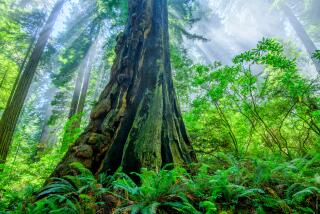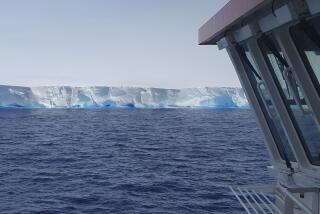When Dreadnoughtus roamed Earth, other dinosaurs got out of the way
In the arid badlands of southern Patagonia, 60 miles off the electrical grid, scientists have unearthed a remarkably complete skeleton of a new species of dinosaur — one of the largest creatures ever to have walked Earth.
This hulking dinosaur stood two stories tall at its shoulder and weighed as much as seven Tyrannosauruses rex. It measured 85 feet from head to tail, including its 37-foot-long neck and 30-foot-long muscular tail.
Scientists are hesitant to say that Dreadnoughtus schrani is the largest dinosaur species that ever lived, but it is certainly right up there.
------------
FOR THE RECORD:
Huge dinosaur: An article in the Sept. 5 Section A about the discovery of a massive Dreadnoughtus schrani dinosaur included an illustration that was credited to Mark A. Klingler of the Carnegie Museum of Natural History. It should have been credited to Jennifer Hall.
------------
Its name is a tribute to its gigantic size. “Dreadnought,” which essentially means “fearing nothing,” was used to describe a class of mammoth battleships that dominated the high seas in the early 20th century.
Nothing could have attacked Dreadnoughtus schrani and won, paleontologists say. It was simply too big.
Based on the size of the femur, or thigh bone, and the humerus, or upper arm bone, scientists believe this Dreadnoughtus weighed 65 tons when it died 66 million to 84 million years ago. (They are still working on getting a more precise age.) That would make it heavier than a Boeing 737.
And here’s the kicker: Skeletal evidence suggests that at the time of its death, the gargantuan creature was still growing.
“There is no doubt that this is among the largest — if not the largest — sauropod dinosaur yet recovered,” said Patrick O’Connor, a paleontologist at Ohio University in Athens, who was not involved in the discovery. That makes it “among the largest of all dinosaurs,” he said.
Paleontologist Kenneth Lacovara of Drexel University in Philadelphia first stumbled on the crumbled remains of the Dreadnoughtus during a fossil-hunting trip in February 2005.
“I found a little cluster of broken-up bones and recorded it in my GPS,” said Lacovara, the lead author of a report on the find, which was published Thursday by the journal Scientific Reports. “But I also recorded 10 other sites on my GPS that morning.”
Even when two of his team members began cleaning the bones later that day and realized that they were pieces of a giant femur bone, Lacovara was blase.
“That’s not uncommon,” he said. “But then there was a tibia, and then a fibula, and at that point we were getting excited.”
The bones themselves were enormous. The animal’s shin bone, for example, was the length of a grown man.
But the thrilling part was that there were so many of them.
“Most sauropods are known by 10 bones,” Lacovara said. “We had 145.”
After all the bones were uncovered, the researchers encased them in plaster “jackets” and shipped them by boat to the U.S. It wasn’t until the fossils had been cleaned and reunited at Lacovara’s lab that the researchers discovered they had bones from two different specimens.
The fossils will ultimately reside in the Museo Padre Molina in Rio Gallegos, Argentina, not far from where they were discovered, but the research team has made 3D laser scans of all the bones, creating what they call a “virtual mount.” The scans will allow other scientists to analyze the bones digitally, and, unlike actual bones, they won’t decay over time.
Paleontologists are particularly excited about the find because the animals were so well preserved, particularly the larger one. More than 45% of that skeleton has been recovered (though its small skull is missing). That will allow scientists to better understand how these enormous animals loped about.
“Such complete specimens of large-bodied sauropods are critical for better developing biomechanical models aimed at understanding how these largest of land-living organisms actually moved around,” O’Connor said.
Dreadnoughtus is a type of titanosaurian sauropod, a diverse group of dinosaurs that lived in the Southern Hemisphere during the final 30 million years of the age of the dinosaurs. These animals would have had to eat almost all the time to sustain their colossal body mass; Lacovara imagines them as eating machines, using their long necks to graze on a wide swath of plant life.
The area where the fossils were found was once a temperate forest that had both conifers and broad-leaf trees. Several rivers ran through it, and Lacovara said he thinks the two dinosaurs died when one of those rivers broke through its natural levee, turning what was solid ground into something like quicksand. In other words, these animals sank to their deaths.
Their untimely deaths were science’s gain.
“The rapid burial is responsible for the extraordinary completeness and beautiful preservation of their bones,” Lacovara said. “We even see muscle scars on many of the bones, and that is because they got buried so fast.”
Steve Salisbury, a scientist who studies dinosaurs at the University of Queensland in Australia, said the discovery could prompt paleontologists to look for other sauropod fossils in some unlikely places.
“Dreadnoughtus shows we might expect to find similarly sized giant sauropods in Antarctica, which would be really exciting,” said Salisbury, who wasn’t part of the study team. “There are indications emerging that there are also giant sauropods in Australia,” which was connected to South America and Antarctica at the time
Salisbury noted that Patagonia has been the site of many important fossil finds because its ancient landscape was conducive to landslides and other events that caused the ancient giants to be entombed almost immediately upon death.
“We have many opportunities to find those fossilized skeletons as they are exposed naturally via modern-day erosion,” he said.
In other words, more big discoveries may be on the way.
For more amazing stories from the world of science, follow me @DeborahNetburn and “like” Los Angeles Times Science & Health on Facebook.







